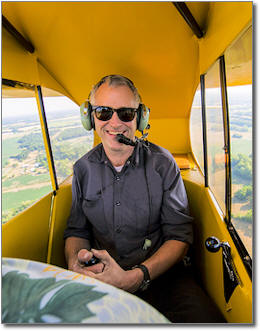Subscriber question:
"Do you always need to apply rudder in a turn to stay coordinated, or are there times when it is not required?" - Steve M.
Rod:
“In flight, the rudder pedals allow you to point the airplane’s nose in the direction of turn. That’s right. That’s what the rudder pedals do. There’s only one occasion where you want the nose to point in a direction opposite the direction the airplane wants to turn and that’s when you’re slipping.
 Since we put rudder pedals on an airplane to help the nose point in the direction the airplane turns, this implies that there are times when the nose wants to point in a direction other than the direction the airplane is banked. How could that happen? Let me explain.
Since we put rudder pedals on an airplane to help the nose point in the direction the airplane turns, this implies that there are times when the nose wants to point in a direction other than the direction the airplane is banked. How could that happen? Let me explain.
We roll an airplane into a bank using our yoke to deflect the ailerons. When entering a right turn, for instance, the right wing aileron deflects upward and the left wing aileron deflects downward. The lift on the right wing decreases and that wing moves downward while the lift on the left wing increases and it moves upward. And, unless you’re flying a rubber airplane over a hot desert, it goes without saying that both wings alternately move up or down simultaneously.
But here’s the rub. In basic aerodynamics, you learned that when you increase lift, you also pay a penalty with an increase in drag. There’s simply no way of getting around this unless you tell me you’re a Jedi Knight, but I know you’re only human. Ahh! Don’t deny it. The wing that goes up—the wing on the outside of any turn—always creates a bit more drag. Therefore, the creation of lift sufficient to raise the outside wing will always create some drag that adversely yaws the airplane’s nose to the outside of the turn arc. The airplane’s natural response to rotating the yoke right or left, is for the nose to yaw in the opposite direction of turn. This response is called, Adverse Yaw.
Adverse yaw is always present any time the ailerons are moved from their neutral or centered position. When the ailerons are deflected, adverse yaw moves the nose opposite the direction you want to turn. The only time this isn’t true is when the airplane has yaw dampers. And the only yaw dampers we have on our smaller airplanes are sticking out the bottom of your pants. That’s right. They’re called your feet.”
